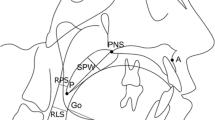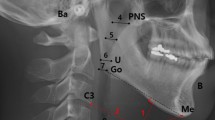Abstract
Introduction
The impact of the dimensional parameters of the pharyngeal bony frame by its length, width and the position of the hyoid upon the severity of obstructive sleep apnea syndrome (OSAS) has not been investigated in depth. Interactions of those parameters with body mass index (BMI) and their overall reciprocal effect on OSAS severity have also not been established.
Materials and Methods
This retrospective cross-sectional study was conducted on 108 male OSAS patients followed in OSAS outpatient clinics between November 2014 and October 2015. They all underwent a polysomnography test, and an apnea–hypopnea index (AHI) was calculated. They also underwent an upper airway computerized tomographic scan in which three craniofacial parameters were evaluated: inter-pterygoid distance (IPD), hard palate-to-hyoid (HP-H) distance, and gnathion plane-to-hyoid (GP-H) distance.
Results
A longer pharynx and an inferiorly placed hyoid bone correlated with the AHI (r = 0.33, p = 0.001 and r = 0.226, p = 0.03, respectively). GP-H correlated with body mass index (BMI) (r = 0.3243, p < 0.001), while HP-H and IPD did not. We found an interaction between BMI and HP-H, but none between GP-H and BMI. IPD did not correlate with OSAS severity, but it correlates with the age of the OSAS patients (r = 0.235, p = 0.015).
Conclusion
Pharynx length and hyoid position have significant effects upon OSAS severity, and they interact differently with BMI in terms of those effects. Hard palate width increases with age but has no correlation with OSAS severity.



Similar content being viewed by others
References
Young T, Palta M, Dempsey J, Skatrud J, Weber S, Badr S (1993) The occurrence of sleep-disordered breathing among middle-aged adults. N Engl J Med 328(17):1230–1235
Marin JM, Carrizo SJ, Vicente E, Agusti AG (2005) Long-term cardiovascular outcomes in men with obstructive sleep apnoea-hypopnoea with or without treatment with continuous positive airway pressure: an observational study. Lancet 365(9464):1046–1053
Xu JX, Cai W, Sun JF, Liao WJ, Liu Y, Xiao JR et al (2015) Serum advanced glycation end products are associated with insulin resistance in male nondiabetic patients with obstructive sleep apnea. Sleep Breath 19(3):827–833
Young T, Finn L, Peppard PE, Szklo-Coxe M, Austin D, Nieto FJ et al (2008) Sleep disordered breathing and mortality: eighteen-year follow-up of the Wisconsin sleep cohort. Sleep 31(8):1071–1078
Teran-Santos J, Jimenez-Gomez A, Cordero-Guevara J (1999) The association between sleep apnea and the risk of traffic accidents. Cooperative Group Burgos-Santander. N Engl J Med 340(11):847–851
Dempsey JA, Veasey SC, Morgan BJ, O’Donnell CP (2010) Pathophysiology of sleep apnea. Physiol Rev 90(1):47–112
Young T, Peppard PE, Taheri S (2005) Excess weight and sleep-disordered breathing. J Appl Physiol 99(4):1592–1599
Romero-Corral A, Caples SM, Lopez-Jimenez F, Somers VK (2010) Interactions between obesity and obstructive sleep apnea: implications for treatment. Chest 137(3):711–719
Peppard PE, Young T, Palta M, Dempsey J, Skatrud J (2000) Longitudinal study of moderate weight change and sleep-disordered breathing. JAMA 284(23):3015–3021
Shelton KE, Woodson H, Gay S, Suratt PM (1993) Pharyngeal fat in obstructive sleep apnea. Am Rev Respir Dis 148(2):462–466
Schwab RJ, Pasirstein M, Pierson R, Mackley A, Hachadoorian R, Arens R et al (2003) Identification of upper airway anatomic risk factors for obstructive sleep apnea with volumetric magnetic resonance imaging. Am J Respir Crit Care Med 168(5):522–530
Kobayashi H, Kato I, Terabayashi T (1988) Anthropometric relevance on sublabial transseptal transsphenoidal hypophysectomy in the Asiatic type of skull. ORL J Otorhinolaryngol Relat Spec 50(5):340–344
Patel Manmohan (2012) Study of the distance between the free edges of Medial Pterygoid Plates in the Skulls of Central Indian Population. Int J Biol Med Res 3(2):1520–1524
Mendelson B, Wong C-H (2012) Changes in the Facial Skeleton with aging: implications and clinical applications in facial rejuvenation. Aesthet Plast Surg 36(4):753–760. https://doi.org/10.1007/s00266-012-9904-3
Chi L, Comyn FL, Mitra N, Reilly MP, Wan F, Maislin G et al (2011) Identification of craniofacial risk factors for obstructive sleep apnoea using three-dimensional MRI. Eur Respir J 38(2):348–358
Buchanan A, Cohen R, Looney S, Kalathingal S, De Rossi S (2016) Cone-beam CT analysis of patients with obstructive sleep apnea compared to normal controls. Imaging Sci Dent 46(1):9–16
Malhotra A, Huang Y, Fogel RB, Pillar G, Edwards JK, Kikinis R et al (2002) The male predisposition to pharyngeal collapse: importance of airway length. Am J Respir Crit Care Med 166(10):1388–1395
Genta PR, Schorr F, Eckert DJ, Gebrim E, Kayamori F, Moriya HT et al (2014) Upper airway collapsibility is associated with obesity and hyoid position. Sleep 37(10):1673–1678
Barkdull GC, Kohl CA, Patel M, Davidson TM (2008) Computed tomography imaging of patients with obstructive sleep apnea. Laryngoscope 118(8):1486–1492
Pae EK, Lowe AA, Fleetham JA (1997) A role of pharyngeal length in obstructive sleep apnea patients. Am J Orthod Dentofacial Orthop 111(1):12–17
Lowe AA, Ono T, Ferguson KA, Pae EK, Ryan CF, Fleetham JA (1996) Cephalometric comparisons of craniofacial and upper airway structure by skeletal subtype and gender in patients with obstructive sleep apnea. Am J Orthod Dentofacial Orthop 110(6):653–664
Bucchieri A, Mastrangelo C, Stella R, Poladas EG (2004) Cephalometric evaluation of hyoid bone position in patients with obstructive sleep apnea. Minerva Stomatol 53(1–2):33–39
Lowe AA, Ozbek MM, Miyamoto K, Pae EK, Fleetham JA (1997) Cephalometric and demographic characteristics of obstructive sleep apnea: an evaluation with partial least squares analysis. Angle Orthod 67(2):143–153
Ferguson KA, Ono T, Lowe AA, Ryan CF, Fleetham JA (1995) The relationship between obesity and craniofacial structure in obstructive sleep apnea. Chest 108(2):375–381
Tangugsorn V, Krogstad O, Espeland L, Lyberg T (2000) Obstructive sleep apnoea: multiple comparisons of cephalometric variables of obese and non-obese patients. J Craniomaxillofac Surg 28(4):204–212
Nelson S, Hans M (1997) Contribution of craniofacial risk factors in increasing apneic activity among obese and nonobese habitual snorers. Chest 111(1):154–162
Sforza E, Bacon W, Weiss T, Thibault A, Petiau C, Krieger J (2000) Upper airway collapsibility and cephalometric variables in patients with obstructive sleep apnea. Am J Respir Crit Care Med 161(2 Pt 1):347–352
Kim AM, Keenan BT, Jackson N, Chan EL, Staley B, Poptani H et al (2014) Tongue fat and its relationship to obstructive sleep apnea. Sleep 37(10):1639–1648
Bixler EO, Vgontzas AN, Ten Have T, Tyson K, Kales A (1998) Effects of age on sleep apnea in men: I. Prevalence and severity. Am J Respir Crit Care Med 157(1):144–148
Young T, Shahar E, Nieto FJ, Redline S, Newman AB, Gottlieb DJ et al (2002) Predictors of sleep-disordered breathing in community-dwelling adults: the Sleep Heart Health Study. Arch Intern Med 162(8):893–900
Young T, Skatrud J, Peppard PE (2004) Risk factors for obstructive sleep apnea in adults. JAMA 291(16):2013–2016
Mayer P, Pepin JL, Bettega G, Veale D, Ferretti G, Deschaux C et al (1996) Relationship between body mass index, age and upper airway measurements in snorers and sleep apnoea patients. Eur Respir J 9(9):1801–1809
Deng X, Gu W, Li Y, Liu M, Li Y, Gao X (2014) Age-group-specific associations between the severity of obstructive sleep apnea and relevant risk factors in male and female patients. PLoS ONE 9(9):e107380
Ayas NT, Pittman S, MacDonald M, White DP (2003) Assessment of a wrist-worn device in the detection of obstructive sleep apnea. Sleep Med 4(5):435–442
Pittman SD, Ayas NT, MacDonald MM, Malhotra A, Fogel RB, White DP (2004) Using a wrist-worn device based on peripheral arterial tonometry to diagnose obstructive sleep apnea: in-laboratory and ambulatory validation. Sleep 27(5):923–933
Pittman SD, Pillar G, Berry RB, Malhotra A, MacDonald MM, White DP (2006) Follow-up assessment of CPAP efficacy in patients with obstructive sleep apnea using an ambulatory device based on peripheral arterial tonometry. Sleep Breath 10(3):123–131
White DP (2008) Monitoring peripheral arterial tone (PAT) to diagnose sleep apnea in the home. J Clin Sleep Med 4(1):73
Zou D, Grote L, Peker Y, Lindblad U, Hedner J (2006) Validation a portable monitoring device for sleep apnea diagnosis in a population based cohort using synchronized home polysomnography. Sleep 29(3):367–374
Acknowledgments
This work was performed in fulfillment of Daniel Ben Ner’s M.D. thesis requirements of the Sackler Faculty of Medicine, Tel Aviv University, Israel. We kindly ask to acknowledge Esther Eshkol for her editorial support.
Author information
Authors and Affiliations
Corresponding author
Ethics declarations
Conflict of interest
There are no conflicts of interest to disclose.
Rights and permissions
About this article
Cite this article
Ben Ner, D., Carmel-Neiderman, N.N., Fliss, D.M. et al. The Interaction Between Craniofacial Computed Tomographic Dimensional Parameters and BMI in Obstructive Sleep Apnea. J. Maxillofac. Oral Surg. 18, 299–306 (2019). https://doi.org/10.1007/s12663-018-1140-1
Received:
Accepted:
Published:
Issue Date:
DOI: https://doi.org/10.1007/s12663-018-1140-1




